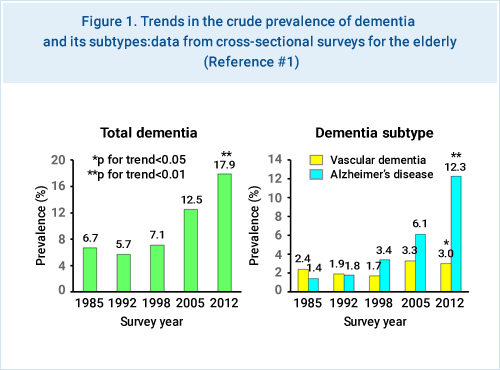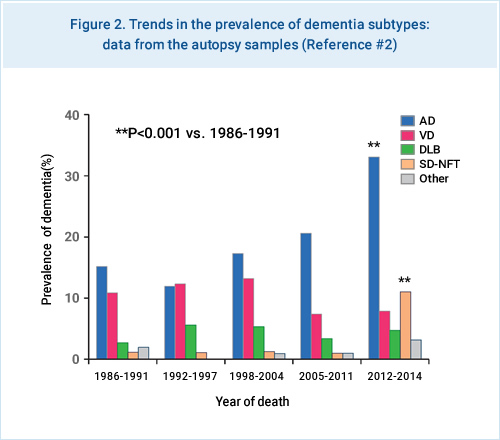HOME > Trends in the prevalence of dementia
Trends in the prevalence of dementia : data from cross-sectional surveys and autopsy samples
Prevalence rates of dementia: the series of the cross-sectional studies

The Hisayama Study have repeated screening examinations for dementia every 6-7 years since 1985, and revealed that the prevalence of dementia, especially Alzheimer’s disease (AD), increased greatly over the past quarter century in a general population of elderly Japanese. The unadjusted prevalence of total dementia increased significantly with time (Figure 1). With regard to dementia subtypes, an increasing trend in the prevalence of AD was observed, while the prevalence of vascular dementia (VD) showed a decreasing trend between 1985 and 1998 and thereafter an increasing trend. Aging of the population is a major cause of the increase in the prevalence of dementia. However, after controlling for the confounding effects of aging, the upward trends in the prevalence of total dementia and AD remained significant, while the increasing trend in the prevalence of VD disappeared. The increasing trend in the incidence of total dementia in Japan may be related to the recent increase in the burden of metabolic disorders, such as diabetes, or the spread of westernized lifestyle behaviors, such as lack of exercise, which have been associated with higher risk of AD.
Autopsy-based prevalence of dementia

One of the most important features of the Hisayama Study is a very high autopsy rates, allowing us to investigate the trends in dementia subtypes pathologically. We investigated the trends in dementia over the past 29 years using 1266 autopsy specimens. To examine the trends in dementia, we divided the autopsy samples into five groups according to the year of death: I (1986-1991), II (1992-1997), III (1998-2004), IV (2005-2011) and V (2012-2014). The prevalence of all-cause dementia significantly increased over time. A similar trend was observed for AD (Figure 2). A rapid increase in senile dementia of the neurofibrillary tangle type (SD-NFT) in recent years was notable. VD was the most common type of dementia prior to 2004; however, its prevalence decreased over time. Our study revealed that tauopathies, including AD and SD-NFT, significantly increased in the aged Japanese population over the course of this study.
References
- 1. Ohara T, et al. Neurology 88: 1925-1932, 2017.
- 2. Honda H, et al. Neuropathology 36: 383-387, 2016.






